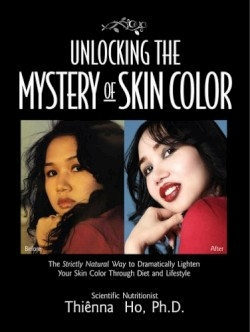Unlocking the Mystery of Skin Color
The Strictly Natural Way to Dramatically Lighten Your Skin Color Through Diet and Lifestyle
- 2007 INDIES Finalist
- Finalist, Health (Adult Nonfiction)
Growing up in wartime Vietnam Thienna Ho yearned for lighter skin—as light perhaps as the other members of her family. She wondered why her own skin was dark and uneven and slow to heal. After her family emigrated to San Francisco Thienna’s curiosity about skin color and skin health led her to acquire several degrees including a graduate certificate in genetic engineering and a doctorate in scientific nutrition. Over the past seven years she has developed and trademarked the Natural Fairskin Method a program of diet lifestyle and supplements that has evened and lightened her own skin.
In Unlocking the Mystery of Skin Color Thienna presents a new science of skin health for those who want lighter healthier younger-looking skin. Readers who may be skeptical of Thienna’s motives and claims will be impressed by her scholarship and the abundance and freshness of her research. She breaks new ground and dispels old myths yet she presents a wide range of scientific knowledge in a fluid readable voice using color photos as well as charts and tables to illustrate her points.
Arguing that “skin color is not fixed” Thienna draws upon the human genome project and current research in genetics anthropology toxicology and nutrition to examine the true determinants of skin color. Many examples such as the Polynesians Lapps and the Lemba of Southern Africa support her idea that nutrition is as important to skin color as genetic inheritance distance from the equator or exposure to sunlight. She then establishes the importance of a mineral nutrient sulfur to skin color and tone. The sulfur content of the amino acids cysteine and methionine promotes the abundance of the lighter-skin pigment pheomelanin. Thienna discovers that the first humans were black; but sulfur-rich lower-toxin diets lightened the skin of early agricultural peoples. Today analysis of the proportions of dietary sulfur and environmental toxins helps to explain anomalies in skin color such as the comparatively light skin of the Javanese or the dark skin of Eskimos.
Analyzing elements of diet and environment for their impact on the body’s sulfur stores Thienna advocates high-protein high-fiber meats and grains. She suggests oven-baking and slow-cooking methods for meats and fish instead of grilling charcoal-broiling and smoking. She warns against “pigging out” on foods that are rich in carotenoids (carrot juice pumpkin sweet potatoes) and warns that beans should undergo several rinses while boiling. Ironically her research supports the myth of her Asian childhood that lighter skin is associated with leisure wealth and health. She links many dark-skinned African peoples for example with cyanogenic foods (such as the staple cassava) that deplete sulfur stores. Poor cultures she finds have little access to protein and fiber and their intake of dietary and environmental toxins is generally high.
But Thienna’s message is not to set people of different colors against each other. “Appreciate what you have” she writes. “Skin colors are merely adaptations made by nature to help our ancestors survive as they migrated around the globe.”
Disclosure: This article is not an endorsement, but a review. The publisher of this book provided free copies of the book and paid a small fee to have their book reviewed by a professional reviewer. Foreword Reviews and Clarion Reviews make no guarantee that the publisher will receive a positive review. Foreword Magazine, Inc. is disclosing this in accordance with the Federal Trade Commission’s 16 CFR, Part 255.

